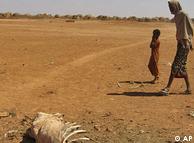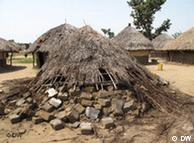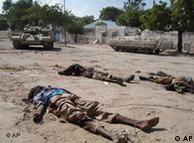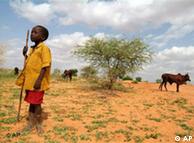Africa | 23.09.2009
East Africa faces a 'perfect storm' as humanitarian disasters combine
The African continent is no stranger to humanitarian disasters. Climatic changes, war, financial hardship and infrastructural chaos seem to regularly take turns in plunging one region or another into desperation. The latest crisis is centered on East Africa, where countries such as Uganda, Ethiopia, Kenya and Somalia are currently experiencing a 'perfect storm' of suffering.
These countries and others in the Horn of Africa are facing a combination of below-average rainfall, the prospect of serious crop failures, increased instability through regional and civil wars, and the overburdening of less severely hit areas through the displacement of populations.
A report by the United Nations Food and Agriculture Organization (FAO) also warns that an already serious food insecurity situation in the region could worsen. The FAO report ominously predicts that if El Nino, the oscillation in ocean temperature which usually brings heavy rains towards the end of the year, delivers as expected, floods and mudslides could add to the misery by wiping out existing food stocks, killing livestock, damaging infrastructure and making thousands homeless.
 Bildunterschrift: Climatic conditions and failed crops have plunged Ethiopia into a growing crisis
Bildunterschrift: Climatic conditions and failed crops have plunged Ethiopia into a growing crisis
Aid agencies are understandably concerned that the already desperate situation of many people in the East Africa region - where nearly 20 million people currently depend on food assistance - could become exacerbated by the growing problems not only spreading between countries but within their own borders.
"Large parts of Kenya, Uganda, Ethiopia and Somalia are affected by drought and food shortages," Tony Durham, from the emergencies department at Action Aid, told Deutsche Welle. "There are also longstanding conflicts in Somalia and northern Uganda. Many refugees from Somalia are living in crowded camps in eastern Kenya.
"The problems vary not just between countries but within countries," he added. "In Kenya for example, there are agricultural areas where crops have failed, and pastoral areas where livestock are dying. Meanwhile the urban population in Nairobi experiences the crisis mainly through power outages and high food prices."
Failing crops and rising prices increase need for aid
 Bildunterschrift: Großansicht des Bildes mit der Bildunterschrift: Villages in Uganda have been abandoned as food dwindles
Bildunterschrift: Großansicht des Bildes mit der Bildunterschrift: Villages in Uganda have been abandoned as food dwindles
The food security situation is driving prices up across the region with staple crops like maize and sorghum in Uganda, Kenya, Sudan and Somalia at double the price they were two years ago. The crops are likely to become even scarcer as predictions suggest many East African nations will see well below average levels for their staple crops in 2009, with the hardest hit areas of Ethiopia seeing a 75 percent loss.
The escalating food crisis in Ethiopia is expected to dramatically increase the number of people in need of emergency assistance to 6.2 million from 1.3 million at present, while in Uganda, a country racked by years of violence between government forces and the rebel Lord's Resistance Army, a 50 percent drop in crop levels is likely to increase the number of people in need of aid beyond a current estimate of one million.
Aid agencies find themselves dealing with a potentially huge humanitarian disaster and are struggling to cope with the realities on the ground. But it didn't need to be like this, according to Sara Pantuliano, head of the humanitarian policy group at the Overseas Development Institute in London.
"This is not an unexpected or unprecedented crisis," she told Deutsche Welle. "There is research into the cycles of drought which affect this region every 3-4 years but the problem is that there are no real mechanisms in place. There are contingencies plans and funds in place but these are insufficient. These plans are often put into operation once the crisis hits and then it’s already too late, the damage has been done. Failed crops can be replanted but will yield in a year from now while dead livestock will take a generation to replace. We need new systems in place. We can’t react to the crisis when it happens."
Somalia's civil war and drought threaten disaster
Conflict-torn Somalia is suffering the most among the striken East African nations with the FAO's Food Security and Nutrition Analysis Unit stating that the food security situation is so dire that the country faces its worst humanitarian crisis in 18 years.
 Bildunterschrift: Großansicht des Bildes mit der Bildunterschrift: Violence in Somalia has caused many people to flee
Bildunterschrift: Großansicht des Bildes mit der Bildunterschrift: Violence in Somalia has caused many people to flee
The current severe drought and escalating violence between radical Islamist rebels, African Union troops and local clan militia has led to an estimated 3.6 million people - approximately half the population - in need of emergency aid. An estimated 1.4 million rural people have been affected by the climatic conditions while 1.3 million have been internally displaced by the civil war.
"Conflict is occurring over water and other resources, and in Kenya several dozen people have been killed in armed clashes," Action Aid's Tony Durham said. "Somalia is so dangerous that aid agency operations are severely limited."
Iris Krebber, the regional director for German aid agency Welthungerhilfe in Kenya, told Deutsche Welle that the increased instability across many countries in the region would exacerbate the current crisis.
"Somalia is just not safe," she said. "Most of the country is a no-go area for aid agencies and not even Somali aid workers can get in. In other places we have the risk of kidnappings and the aid actually being hijacked and not getting to those who need it that way. But it isn't just a problem in Somalia. We see this phenomenon of conflict exacerbating a natural disaster in Kenya and Uganda where the drought emergency is turning previously peaceful regions into conflict zones."
Aid agencies under-fire and under-funded
It is not just the conditions and dangers on the ground in places like Somalia that are hindering aid efforts. Durham believes that a lack of funding for agencies and organizations is severely limiting the impact which can be made in East Africa.
"Action Aid and other humanitarian agencies are distributing food provided by the World Food Program (WFP)," Durham said. "However, the WFP is severely under-funded as a result of the global recession, and has warned that it will have to reduce food aid to East Africa unless donor countries act to fill the funding gap."
Iris Krebber agreed: "We have never seen such a shortfall in aid and funding for East Africa as we have now," she said. "Food relief is less than 50 percent of what is needed, and usually it's non-food items that suffer in a funding shortfall. But what is needed more is water, and we have just 10 percent of the funding we needed to provide enough drinking water. It's not just western governments who should do more but those functioning governments in East Africa must help themselves by contributing more."
Asked whether it was too late to avoid a wide-scale humanitarian disaster, Krebber replied: "This is already a wide-scale crisis. But if we can save just one life then it is never too late."
Author: Nick Amies
Editor: Rob Mudge


No comments:
Post a Comment